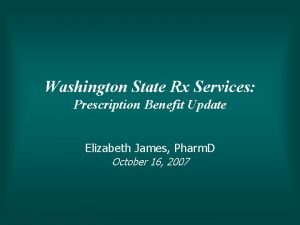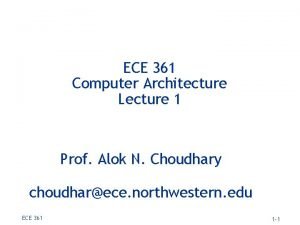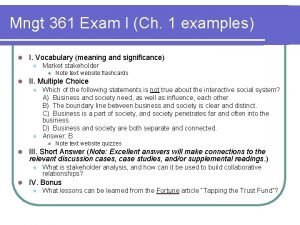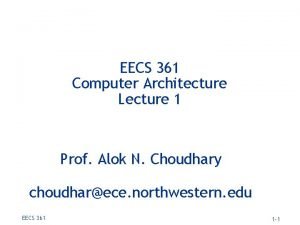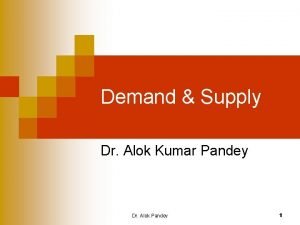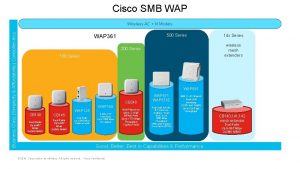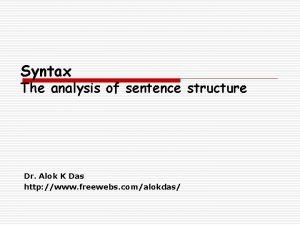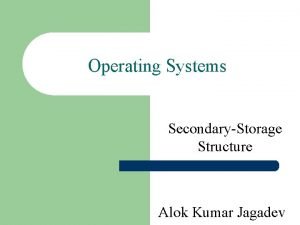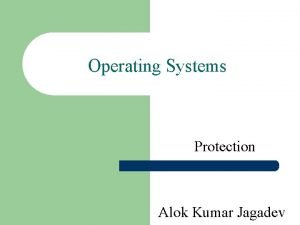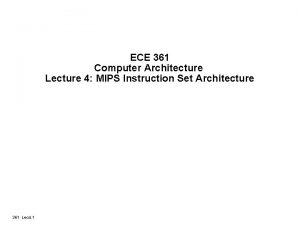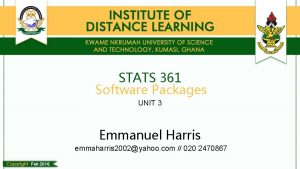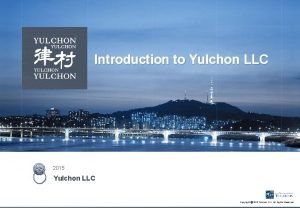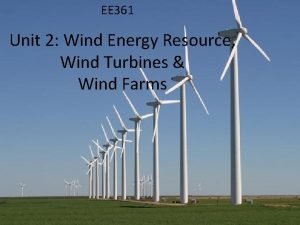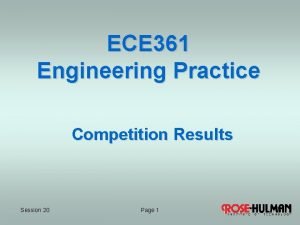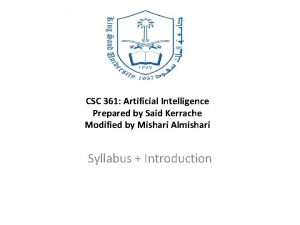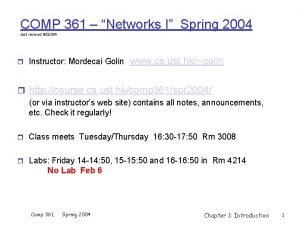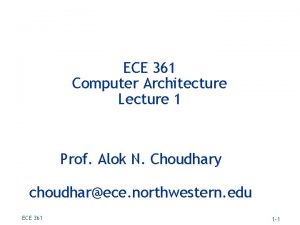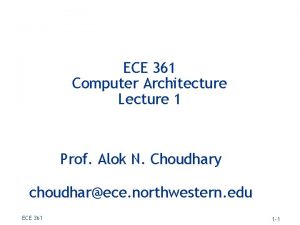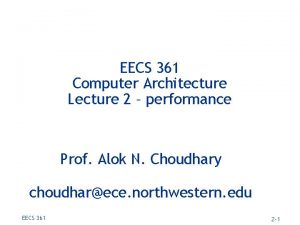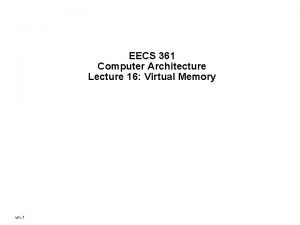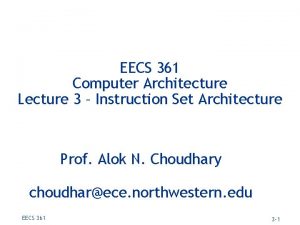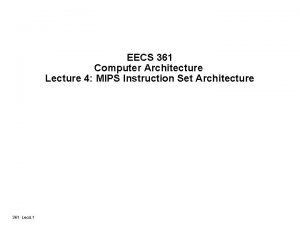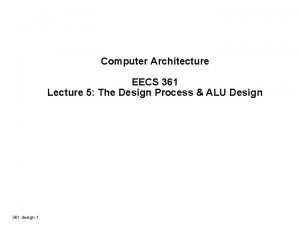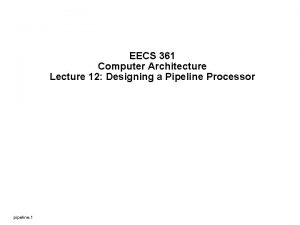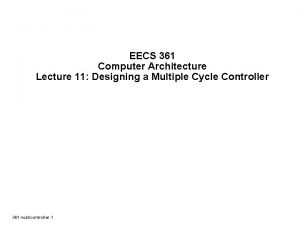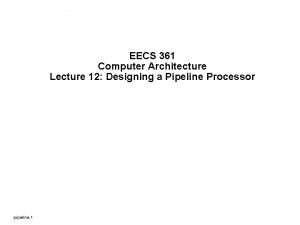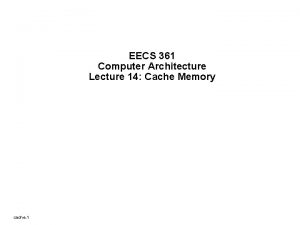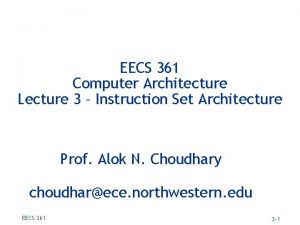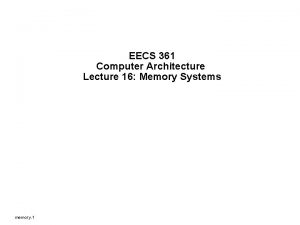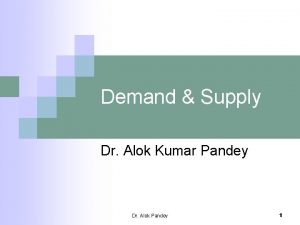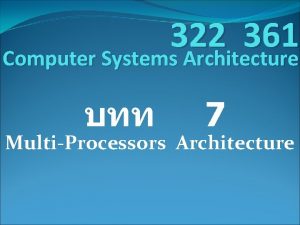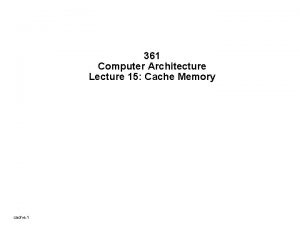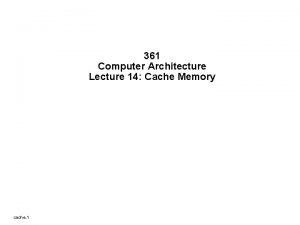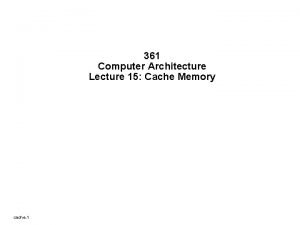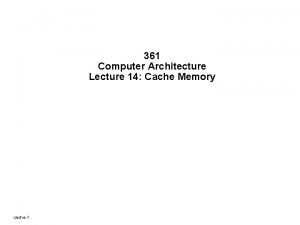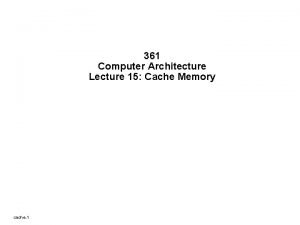EECS 361 Computer Architecture Lecture 1 Prof Alok





![Levels of Representation High Level Language Program temp = v[k]; v[k] = v[k+1]; v[k+1] Levels of Representation High Level Language Program temp = v[k]; v[k] = v[k+1]; v[k+1]](https://slidetodoc.com/presentation_image/4915c7ebdbfc3afac8f4b049ce7f35a6/image-6.jpg)


































- Slides: 40

EECS 361 Computer Architecture Lecture 1 Prof. Alok N. Choudhary choudhar@ece. northwestern. edu EECS 361 1 -1

Class Info: Timings: • Tue-Thu 11: 00 -12: 20 Tech M 128 Class Web Site: http: //www. ece. northwestern. edu/~ada 829/ece 361/ Teaching Assistants: • Avery Ching [ aching@ece. northwestern. edu ] Office: Tech L 460 Phone: 847 -467 -2299 • Abhishek Das [ ada 829@ece. northwestern. edu ] Office: Tech L 458 Phone: 847 -4610 Announcement: Mid Term Exam on Nov 14 2006 EECS 361 1 -2

Today’s Lecture Computer Design • Levels of abstraction • Instruction sets and computer architecture Architecture design process Interfaces Course Structure Technology as an architectural driver • Evolution of semiconductor and magnetic disk technology • New technologies replace old • Industry disruption Cost and Price Break • Semiconductor economics EECS 361 1 -3

Computers, Levels of Abstraction and Architecture EECS 361 1 -4

Computer Architecture’s Changing Definition 1950 s Computer Architecture • Computer Arithmetic 1960 s • Operating system support, especially memory management 1970 s to mid 1980 s Computer Architecture • Instruction Set Design, especially ISA appropriate for compilers • Vector processing and shared memory multiprocessors 1990 s Computer Architecture • Design of CPU, memory system, I/O system, Multi-processors, Networks • Design for VLSI 2000 s Computer Architecture: • Special purpose architectures, Functionally reconfigurable, Special considerations for low power/mobile processing, highly parallel structures EECS 361 1 -5
![Levels of Representation High Level Language Program temp vk vk vk1 vk1 Levels of Representation High Level Language Program temp = v[k]; v[k] = v[k+1]; v[k+1]](https://slidetodoc.com/presentation_image/4915c7ebdbfc3afac8f4b049ce7f35a6/image-6.jpg)
Levels of Representation High Level Language Program temp = v[k]; v[k] = v[k+1]; v[k+1] = temp; Compiler Assembly Language Program lw lw sw sw $15, $16, $15, 0($2) 4($2) Assembler Machine Language Program 0000 1010 1100 0101 1001 1111 0110 1000 1100 0101 1010 0000 0110 1000 1111 1001 1010 0000 0101 1100 1111 1000 0110 0101 1100 0000 1010 1000 0110 1001 1111 Machine Interpretation Control Signal Spec EECS 361 ALUOP[0: 3] <= Inst. Reg[9: 11] & MASK 1 -6

Levels of Abstraction Graphical Interface Application Programming Application Libraries System Programming Operating System Programming Language Assembler Language Instruction Set Architecture - “Machine Language” Processor IO System Firmware Computer Design Datapath and Control Logic Design Circuit Design Fabrication EECS 361 Semiconductors Microprogramming Digital Design Circuits and devices Materials 1 -7

The Instruction Set: A Critical Interface Computer Architecture = Instruction Set Architecture + Machine Organization Instruction Set Design • • Machine Language Compiler View "Computer Architecture" "Instruction Set Architecture" "Building Architect" software instruction set hardware This course Computer Organization and Design • Machine Implementation • Logic Designer's View • "Processor Architecture" • "Computer Organization" "Construction Engineer" EECS 361 1 -8

Instruction Set Architecture Data Types Encoding and representation Architecture Reference Manual Memory Model Principles of Operation Program Visible Processor State General registers Program counter Processor status Programming Guide … Instruction Set Instructions and formats Addressing modes Data structures System Model States Privilege Interrupts IO External Interfaces IO Management EECS 361 . . . the attributes of a [computing] system as seen by the programmer, i. e. the conceptual structure and functional behavior, as distinct from the organization of the data flows and controls the logic design, and the physical implementation. Amdahl, Blaaw, and Brooks, 1964 1 -9

Computer Organization Capabilities & Performance Characteristics of Principal Functional Units (e. g. , Registers, ALU, Shifters, Memory Management, etc. Ways in which these components are interconnected • Datapath - nature of information flows and connection of functional units • Control - logic and means by which such information flow is controlled Choreography of functional units to realize the ISA Register Transfer Level Description / Microcode “Hardware” designer’s view includes logic and firmware EECS 361 1 -10

This Course Focuses on General Purpose Processors A general-purpose computer system • Uses a programmable processor • Can run “any” application • Potentially optimized for some class of applications • Common names: CPU, DSP, NPU, microcontroller, microprocessor Unified main memory • For both programs & data • Von Neumann computer Busses & controllers to connect processor, memory, IO devices Processor Input Control Datapath Memory Output MIT Whirlwind, 1951 Computers are pervasive – servers, standalone PCs, network processors, embedded processors, … EECS 361 1 -11

Today, “Computers” are Connected Processors Proc Caches Busses Memory adapters Controllers I/O Devices: Disks Displays Keyboards Networks All have interfaces & organizations EECS 361 1 -12

What does a computer architect do? Drivers Work Products Business, product management, marketing Measurement and Evaluation Translates business and technology drives into efficient systems for computing tasks. EECS 361 1 -13

Metrics of Efficiency - Examples Desktop computing • Examples: PCs, workstations • Metrics: performance (latency), cost, time to market Server computing • Examples: web servers, transaction servers, file servers • Metrics: performance (throughput), reliability, scalability Embedded computing • Examples: microwave, printer, cell phone, video console • Metrics: performance (real-time), cost, power consumption, complexity EECS 361 1 -14

Applications Drive Design Points Numerical simulations • Floating-point performance • Main memory bandwidth Transaction processing • I/Os per second and memory bandwidth • Integer CPU performance Media processing • Repeated low-precision ‘pixel’ arithmetic • Multiply-accumulate rates • Bit manipulation Embedded control • I/O timing • Real-time behavior EECS 361 Architecture decisions will often exploit application behavior 1 -15

Characteristics of a Good Interface Design Well defined for users and implementers Interoperability (Hardware) / Compatibility (Software) • Lasts through multiple implementations across multiple technologies (portability, compatibility) • Efficiently supports multiple implementations - Competitive market - Compatible at multiple cost / performance design points IP Investment Preservation • Extensible function grows from a stable base • Generality of application permits reuse of training, tools and implementations Applies to many types of interfaces • Instruction set architectures • Busses • Network protocols • Library definitions • OS service calls • Programming languages EECS 361 Use 2 Use 3 imp 1 Interface time imp 2 imp 3 Interface usage can far exceed the most optimistic projections of it’s designer: • Instruction sets - S/360 1964 ~ present - X 86 1972 ~ present - SPARC 1981 ~ present • Network protocols - Ethernet 1973 ~ present - TCP/IP 1974 ~ present • Programming languages - C 1973 ~ present 1 -16

Course Structure EECS 361 1 -17

What You Need to Know from prerequisites Basic machine structure • Processor, memory, I/O Assembly language programming Simple operating system concepts Logic design • Logical equations, schematic diagrams, FSMs, Digital design EECS 361 1 -18

Roadmap 1000 CPU “Moore’s Law” Arithmetic Processor-Memory Performance Gap: (grows 50% / year) 10 DRAM 9%/yr. DRAM (2 X/10 yrs) 1982 1983 1984 1985 1986 1987 1988 1989 1990 1991 1992 1993 1994 1995 1996 1997 1998 1999 2000 1 1980 1981 Single/multicycle Datapaths Performance 100 µProc 60%/yr. (2 X/1. 5 yr) Time IFetch. Dcd Exec Mem IFetch. Dcd WB Exec Mem WB Pipelining I/O EECS 361 Memory Systems 1 -19

Course Basics Website • • www. ece. northwestern. edu/~ada 829/ece 361/ Check regularly for announcements All course materials posted -- lecture notes, homework, labs, supplemental materials Communicate information, questions and issues Office Hours – Tech L 469 - Tuesday 2 -3 pm (or by appointment) Text supplements lectures and assigned reading should be done prior to lectures. I assume that all assigned readings are completed even if the material is not covered in class. Homework, Labs and Exams • Collaborative study and discussion is highly encouraged • Work submitted must be your own • Individual grade Project • Collaborative effort • Team grade EECS 361 1 -20

Grade 35% Homework and Labs • 4 homework sets • Lab – individual grade, collaboration is strongly encouraged - ALU 30% Team Project • MIPS subset • Design and CAD intensive effort 35% Late midterm Exam (Nov 14) • Open book, open notes EECS 361 1 -21

Project Teams of 3 -4 students You will be required to • Use advanced CAD tools – Mentor Graphics • Design a simple processor (structural design and implementation) – MIPS subset • Validate correctness using sample programs of your own and provided as part of the assignment Written presentation submitted (due Dec 1, 2006) You may also use VHDL (structural) to design your system if you know VHDL sufficiently well EECS 361 1 -22

Course Structure Lectures: • • 1 2 4 2 week on Overview and Introduction (Chap 1 and 2) weeks on ISA Design weeks on Proc. Design weeks on Memory and I/O Reading assignments posted on the web for each week. Please read the appropriate material before the class. Note that the above is approximate Copy of all lecture notes available from the department for a charge (bound nicely) EECS 361 1 -23

Technology Drivers EECS 361 1 -24

Technology Drives Advances in Computer Design Evolution Each level of abstraction is continually trying to improve Disruption Fundamental economics or capability cross a major threshold EECS 361 1 -25

Significant technology disruptions Logic Relays Vacuum tubes single transistors SSI/MSI (TTL/ECL) VLSI (MOS) Registers Delay lines drum semiconductor Memory Delay lines magnetic drum core SRAM DRAM External Storage Paper tape Paper cards magnetic drum magnetic disk Today, technology is driven by semiconductor and magnetic disk technology. What are the next technology shifts? EECS 361 1 -26

Semiconductor and Magnetic Disk Technologies Have Sustained Dramatic Yearly Improvement since 1975 Moore’s “Law” - The observation made in 1965 by Gordon Moore, co-founder of Intel, that the number of transistors per square inch on integrated circuits had doubled every year since the integrated circuit was invented. Moore predicted that this trend would continue for the foreseeable future. In subsequent years, the pace slowed down a bit, but data density has doubled approximately every 18 months, and this is the current definition of Moore's Law, which Moore himself has blessed. Most experts, including Moore himself, expect Moore's Law to hold for at least another two decades. EECS 361 1 -27

Device Density Increases Faster Than Die Size 1996 1971 HP PA 8000 – 17. 68 mmx 19. 1 mm, 3. 8 M transistors. Intel 4004 was a 3 chip set with a 2 kbit ROM chip, a 320 bit RAM chip and the 4 bit processor each housed in a 16 pin DIP package. The 4004 processor required roughly 2, 300 transistors to implement, used a silicon gate PMOS process with 10µm linewidths, had a 108 KHz clock speed and a die size of 13. 5 mm 2. Designer – Ted Hoff. Source: http: //micro. magnet. fsu. edu/chipshots/ EECS 361 1 -28

Example: Intel Semiconductor Roadmap Source: Mark Bohr, Intel, 2002 EECS 361 1 -29

DRAM Drives the Semiconductor Industry size 100000 Year 1980 10000 Bits 10000000 1983 1000000 1986 100000 1989 10000 1992 1000 1975 1980 1985 Year 1990 1995 2000 1996 1999 EECS 361 2002 Capacity 64 Kb 250 ns 256 Kb 220 ns 1 Mb 190 ns 4 Mb 165 ns 16 Mb 145 ns 64 Mb 120 ns 256 Mb 100 ns 1 Gb 80 ns Access 1 -30

Log Performance Memory Wall: Speed Gap between Processor and DRAM Processor 60% per year DRAM 7% per year Year Source: Junji Ogawa, Stanford EECS 361 The divergence between performance and cost drives the need for memory hierarchies, to be discussed in future lectures. 1 -31

Semiconductor evolution drives improved designs 1970 s • Multi-chip CPUs • Semiconductor memory very expensive • Complex instruction sets (good code density) • Microcoded control 1980 s • 5 K – 500 K transistors • Single-chip CPUs • RAM is cost-effective • Simple, hard-wired control • Simple instruction sets • Small on-chip caches 1990 s • 1 M - 64 M transistors • Complex control to exploit instruction-level parallelism • Super deep pipelines 2000 s • 100 M - 5 B transistors • Slow wires • Power consumption • Design complexity EECS 361 Note: Gate speeds and power/cooling also improved 1 -32

Why Such Change in 10 years? Performance • Technology Advances - CMOS VLSI dominates older technologies (TTL, ECL) in cost and performance • Computer architecture advances improves low-end - RISC, superscalar, RAID, … Price: Lower costs due to … • Simpler development - CMOS VLSI: smaller systems, fewer components • Higher volumes - CMOS VLSI : same dev. cost 1, 000 vs. 100, 000 units • Lower margins by class of computer, due to fewer services Function • Rise of networking / local interconnection technology EECS 361 1 -35

Cost and Price EECS 361 1 -36

Integrated Circuit Manufacturing Costs IC yield is a largely a function of defect density. Yield curves improve over time with manufacturing experience. EECS 361 1 -37

Relationship of complexity, cost and yield Cost per function Generational Improvements R&D and semiconductor equipment suppliers Larger wafers Improved materials Finer feature sizes Number of functions per chip Yield Improvement Yield Time • Learning curve: manufacturing costs decrease over time measured by change in yield Manufacturing Volume Chip Area • Decreases the time needed to get down the learning curve • Decreases the cost due to improved manufacturing efficiency Source: The History of the Microcomputer - Invention and Evolution, Stan Mazor EECS 361 1 -38

Example: FPGA Cost per 1 M Gates Improves 65% per year Source: Xilinx EECS 361 1 -39

System Cost Example: Web Server System Subsystem % of total cost Cabinet Sheet metal, plastic Power supply, fans Cables, nuts, bolts (Subtotal) (4%) 1% 2% 1% Motherboard Processor DRAM 20% I/O system 10% Network interface Printed Circuit board (Subtotal) (60%) 20% I/O Devices Disks (Subtotal) 4% 1% 36% (36%) Picture: http: //developer. intel. com/design/servers/sr 1300/ EECS 361 1 -40

Example: Cost vs Price Average selling price Profit (5 -20%) Distribution +50– 80% Costs +25– 100% (33– 45%) (33– 14%) Op Costs +33% Direct Costs (8– 10%) Component Cost Input: chips, displays, . . . EECS 361 (25– 31%) Making it: labor, scrap, returns, . . . R&D, rent, marketing, admin, . . . Commission, discounts, channel support 1 -41

Summary Computer Design • Levels of abstraction • Instruction sets and computer architecture Architecture design process Interfaces Course Structure Technology as an architectural driver • Evolution of semiconductor and magnetic disk technology • New technologies replace old • Industry disruption Cost and Price • Semiconductor economics EECS 361 1 -42
 Architecture lecture notes
Architecture lecture notes Microarchitecture vs isa
Microarchitecture vs isa Washington state prescription services
Washington state prescription services Alok adholeya
Alok adholeya Dr alok mohan
Dr alok mohan Ece 361
Ece 361 Alok vijayant
Alok vijayant Mngt 361 exam 1
Mngt 361 exam 1 Cache do alok
Cache do alok Dr alok kumar pandey
Dr alok kumar pandey Smbse cisco training
Smbse cisco training The boy saw the man with the telescope
The boy saw the man with the telescope Alok kumar jagadev
Alok kumar jagadev Alok kumar jagadev
Alok kumar jagadev Ece 361
Ece 361 Stats 361
Stats 361 Hymn 361
Hymn 361 Alok kipo mena
Alok kipo mena Darrieus vawt
Darrieus vawt Ece 361
Ece 361 Alok gupta md
Alok gupta md Said kerrache
Said kerrache Comp 361
Comp 361 01:640:244 lecture notes - lecture 15: plat, idah, farad
01:640:244 lecture notes - lecture 15: plat, idah, farad 3 bus architecture
3 bus architecture Difference between architecture and organization
Difference between architecture and organization Design of basic computer in computer architecture
Design of basic computer in computer architecture Computer security 161 cryptocurrency lecture
Computer security 161 cryptocurrency lecture Computer-aided drug design lecture notes
Computer-aided drug design lecture notes Architecture business cycle in software architecture
Architecture business cycle in software architecture Data centered architecture
Data centered architecture Modular architecture vs integrated architecture
Modular architecture vs integrated architecture Product architecture examples
Product architecture examples Computer organization and architecture 10th solution
Computer organization and architecture 10th solution Intel pentium
Intel pentium Iit kharagpur virtual lab coa
Iit kharagpur virtual lab coa Introduction to computer organization and architecture
Introduction to computer organization and architecture Timing and control in computer architecture
Timing and control in computer architecture Evolution of computer architecture
Evolution of computer architecture Dma controller in computer architecture
Dma controller in computer architecture Fp adder
Fp adder


